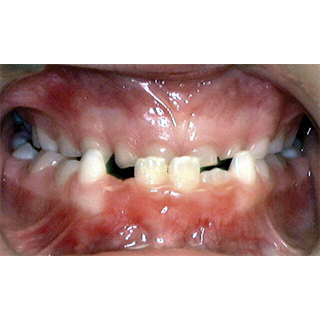
Dr. Wang and the American Association of Orthodontists recommend all children should see an orthodontist by this age because the first set of permanent molars and incisors have usually erupted. This is the ideal time to evaluate your child’s tooth relationships and facial pattern to check for proper balance, symmetry and growth. This evaluation may reveal that development is fine and early treatment is not needed. Or, Dr. Wang may identify a developing problem but recommend monitoring your child’s growth and development, and then, if indicated, begin treatment at the appropriate time. In other cases, Dr. Wang might find a problem that can benefit from early treatment.
If early treatment is indicated, Dr. Wang will recommend a Phase One plan to help guide the growth of the jaws and incoming permanent teeth. Phase One treatment may prevent or intercept more serious problems from developing and may make treatment at a later age shorter and less complicated. In some cases, Dr. Wang will be able to achieve results that may not be possible once the face and jaws have finished growing.
can also regulate the width of the dental arches, create space for permanent teeth, avoid the need for permanent teeth extractions, reduce the likelihood of impacted teeth, correct thumb sucking, and eliminate abnormal swallowing or speech problems. Common Phase One treatments may include partial braces, expanders, space maintainers, headgears or retainers.
After Phase One treatment is completed, there is usually a rest period when the remaining permanent teeth are allowed to erupt. Dr. Wang will continue to monitor your child’s dental and jaw development during periodic recall observation appointments. The teeth are still not in their final positions, as this will be determined and accomplished in the second phase of treatment.



The goal of the second phase (also considered Full Treatment if no early treatment was needed) is to make sure each tooth has an exact location in the mouth where it is in harmony with the lips, cheeks, tongue, and other teeth. When this equilibrium is established, the teeth will function together properly. The second phase will generally begin after all the baby teeth have fallen out and permanent teeth have come in, usually around 12-13 years old. Treatment options for this phase will depend on your child’s individual needs. Some kids and teens will need braces with rubber bands, while others will need Invisalign. Once the teeth are in their final positions, retainers will be worn to ensure you retain your beautiful smile.



An underbite occurs when the lower teeth sit in front of the upper teeth when back teeth are closed. This is caused by an undergrowth of the upper jaw, overgrowth of the lower jaw, or both. An underbite can cause poor chewing, speech impairment, excessive tooth wear, and can cause painful jaw/joint problems.
